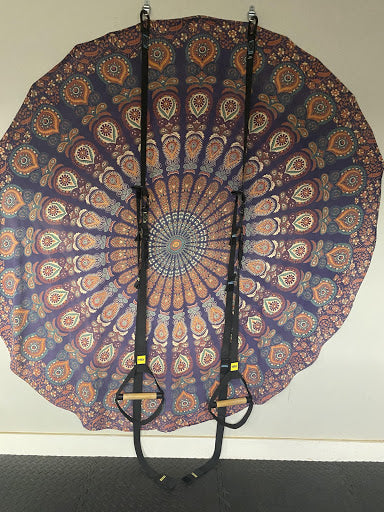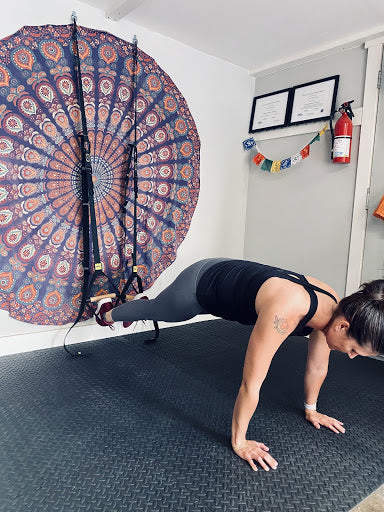TRX Suspension Trainer Workout
There is no one-size-fits-all solution when it comes to fitness. Goals and aspirations vary widely from person to person. Most of us just want to be healthy enough to enjoy our favorite activities, while others have very specific performance goals. Whatever your vision of fitness is, one thing is for certain; Variation matters. Doing the same routine every week, using the same weights, running the same distances, can all help to keep you on track. But eventually your body will learn to adapt to your routine. That’s when it’s time to change things up. You can do this by adding more weight to your barbell, or by using...no weights at all? Sometimes it’s not necessarily the weight that matters, but rather the modality. This is where suspension training comes in.
Like so many of our newly-minted home gyms, the TRX was born out of necessity back in 1997. Navy SEAL Squadron Commander Randy Hetrick was looking for a way to strength train while on assignment when he cleverly fashioned the TRX prototype out of a jiu jitsu belt and some parachute webbing. The first official TRX was developed in 2001 after Hetrick earned his MBA from Stanford University. Three years later in 2004, Hetrick began selling the Travel X- the precursor to the TRX we know today- out of the trunk of his car in San Francisco. By 2005, TRX had launched Suspension Training courses for Personal Trainers and Coaches nationwide. In 2007, TRX FORCE launched as a military training program used by the US Marine Corps. Today TRX trainers can be found everywhere from commercial gyms and yoga studios to homes across the country.

So, what is this thing exactly? The TRX is basically two long nylon straps of adjustable length; it features a solid metal clip at one end, and either a wooden or a rubber handle at the other end, as well as a nylon foothold. It can be attached to a doorway using a TRX anchor strap (included with most TRXs), or by using a solid wall mounted anchor kit. Velcro strips run along the length of the straps to allow for a shorter or longer strap depending on which exercise you’re doing. Using the velcro straps also allows users to attach the main straps to everything from outdoor soccer goals, to the chin-up bar on a barbell rig. My TRX hangs prominently in our garage gym and is used daily, for everything from overhead stretches to hamstring curls.
There are seven foundational movements the human body performs: Push, pull, squat, lunge, hinge, rotation, and gait. Any exercise you do is just a variation on one of those movements. So it’s really important to be able to execute those movements correctly, especially before adding any additional weight. All of these movements can be safely learned, practiced, and executed using the TRX.
For those who are new to fitness, I like to start with a bodyweight squat. Though squatting is an everyday movement, many of us don’t execute it correctly. The knees come out way over our toes adding stress to the patella, or the upper body leans forward as we descend toward the ground. Both of these compensations can be addressed by holding the handles of the TRX while coming down into a squat position with weight set in the heels. Down then up. Repeat. Boom. There’s that solid squat foundation!

The TRX is also great with helping users to really ~feel~ the movements. Sounds silly, but developing good mind/muscle connection in a strength training routine is paramount. For example, let’s talk about push-ups. A lot of people consider push-ups to be an arm exercise (which isn’t totally untrue). But push-ups are intended to work the pectoral muscles in your chest. Push-ups are HARD, and it can take awhile to develop the strength to execute one correctly on the ground. Not so with the TRX. Practicing push-ups on the TRX allows users to move safely through a full range of motion and really feel those pecs working.

What about the seasoned athletes, the gym rats, the Swoletariat? Can the TRX be used to spice up an already spicy fitness routine? As they say back in my hometown of Milwaukee, “Oh, you betcha!”. There are lots of ways we can add variety to our fitness routines, whether it’s challenging our proprioception, or doing focused balance work. One of my favorites is ipsilateral work, or working one side of the body at a time. The TRX is fantastic for things like single-leg pistol squats. Start with your feet shoulder-width apart and both hands on the handles. Pick one foot up off the ground and gently push your hips back as if sitting down in a chair. Bring your body as low to the ground as you can before driving through the heel to stand back up again, all while relying on the TRX straps as little as possible. Complete 3 sets of 10. Try not to hate me tomorrow when those DOMs set in.

Let’s not forget everyone’s favorite: core work. At the beginning of shelter-in-place, I challenged myself to a ‘CORE-antine’ challenge. 3-4 sets of 2-3 different core exercises at the end of my daily workout. Initially I started with the basics, like planks and scissor kicks on the ground. As my strength improved each week, I started adding the TRX into my core routine. First I was doing forearm planks with my feet in the footholds for time (yowza!). Eventually I advanced to incorporating knee tucks and pikes using the foothold. Now, not only is my core the strongest that it’s ever been, but I’ve also developed good total body stability and shoulder strength as a result. Suspension training for the win!
In a recent survey for TD Ameritrade’s lifestyle and finances report, 59% of respondents said they don’t plan on renewing their gym memberships once the covid pandemic ends. Fitness enthusiasts have moved their workouts outdoors and into their garages. The gyms we once knew may not ever exist again. If you are among the 59%, you may be wondering what you really need to stay fit at home. Dumbbells and barbells are obvious choices, but have been difficult to find in recent months. Resistance bands are good options for a lower body workout, but what about the arms and back?. If you’re looking for a quality total body option, the TRX is hard to beat. So much is possible, all with a piece of equipment that weighs less than a Hydroflask and can be tucked away into a dresser drawer. Bonus points for being much more affordable than a gym membership! The TRX Strong System is priced at $149.99 and can be found at your local Sports Basement.